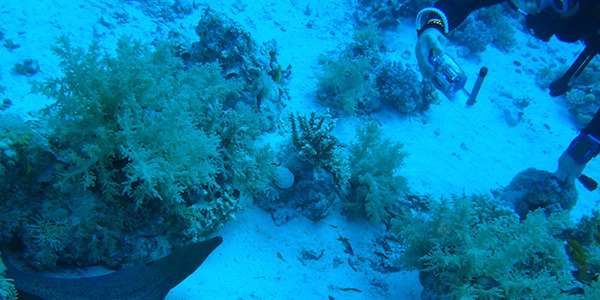 <p>The marine landscape of the reef is a beautiful wall dropping to a depth of more than 180 meters. Extraordinarily rich in multicoloured corals: one of the most concentrated growths on this part of the coast. In particular - the pink soft corals for which the site is named. Dive at an average depth of about 15 m, this is where you will see the largest concentration of soft corals.</p>
<p>The marine landscape of the reef is a beautiful wall dropping to a depth of more than 180 meters. Extraordinarily rich in multicoloured corals: one of the most concentrated growths on this part of the coast. In particular - the pink soft corals for which the site is named. Dive at an average depth of about 15 m, this is where you will see the largest concentration of soft corals.</p>
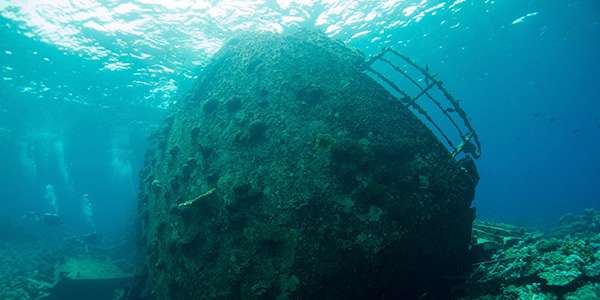 On the north of Tiran Island, this can only be dived in extremely good sea conditions but is an absolute gem. The twisted wreckage of this large container ship is in only 6 - 8 metres of water and surrounded by prolific hard coral.
On the north of Tiran Island, this can only be dived in extremely good sea conditions but is an absolute gem. The twisted wreckage of this large container ship is in only 6 - 8 metres of water and surrounded by prolific hard coral.
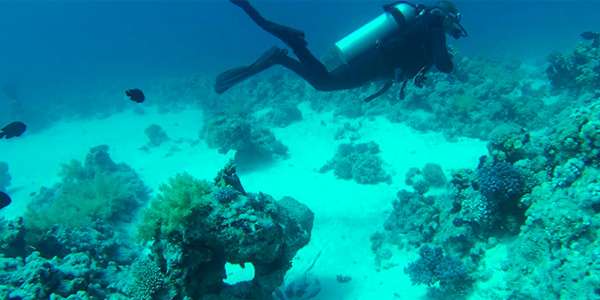 The western side of Tiran Island itself is divided into two parts which scuba divers generally refer to as North and South Laguna. Both marked by beacons these are beautiful drift dives which can be done only when the weather conditions are exceptionally good. The area is strongly influenced by tidal currents which will determine the southerly or northerly direction of your dives which should be made preferably in the afternoon. Rich in coral and reef fauna it is possible to observe Leopard Sharks and White Tip Reef Sharks.
The western side of Tiran Island itself is divided into two parts which scuba divers generally refer to as North and South Laguna. Both marked by beacons these are beautiful drift dives which can be done only when the weather conditions are exceptionally good. The area is strongly influenced by tidal currents which will determine the southerly or northerly direction of your dives which should be made preferably in the afternoon. Rich in coral and reef fauna it is possible to observe Leopard Sharks and White Tip Reef Sharks.
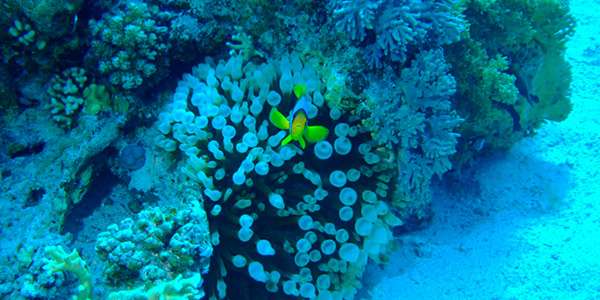 Here you will see the best coral garden in Sharm El Sheikh. The site is one of the best and most famous in the Red Sea. It has an amazing underwater landscape. The most dived part of the reef is the southern end due to its calm waters. At 27m lies a Red Anemone, which, in spite of the depth, is bright red. The coral garden is at the western corner of the reef, between 5 and 12m. It resembles a big aquarium, with schools of Black Snappers, Red Tooth Triggerfish and Cornet Fish. The northern part of the reef is dived when the sea is calm, usually in the summer. This dive is done in blue water, to search for a school of Scalloped Hammerheads! On this side you find the wreck of Lara at a depth of between 45 and 120m. The Lara is great for Tec divers.
Here you will see the best coral garden in Sharm El Sheikh. The site is one of the best and most famous in the Red Sea. It has an amazing underwater landscape. The most dived part of the reef is the southern end due to its calm waters. At 27m lies a Red Anemone, which, in spite of the depth, is bright red. The coral garden is at the western corner of the reef, between 5 and 12m. It resembles a big aquarium, with schools of Black Snappers, Red Tooth Triggerfish and Cornet Fish. The northern part of the reef is dived when the sea is calm, usually in the summer. This dive is done in blue water, to search for a school of Scalloped Hammerheads! On this side you find the wreck of Lara at a depth of between 45 and 120m. The Lara is great for Tec divers.
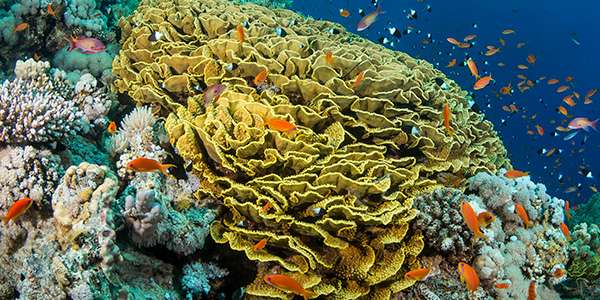 This is the longest reef in the Straits of Tiran. The highlight of this reef is a wall that starts from the surface, reaching about 45m. Here divers find crevices with resident Giant Morays, as well as Groupers and Puffer Fish. Near the wall are pinnacles where divers might find Nudibranchs and Pipe Fish. Giant Barracudas and Jacks cruise past in the blue away from the reef.
This is the longest reef in the Straits of Tiran. The highlight of this reef is a wall that starts from the surface, reaching about 45m. Here divers find crevices with resident Giant Morays, as well as Groupers and Puffer Fish. Near the wall are pinnacles where divers might find Nudibranchs and Pipe Fish. Giant Barracudas and Jacks cruise past in the blue away from the reef.
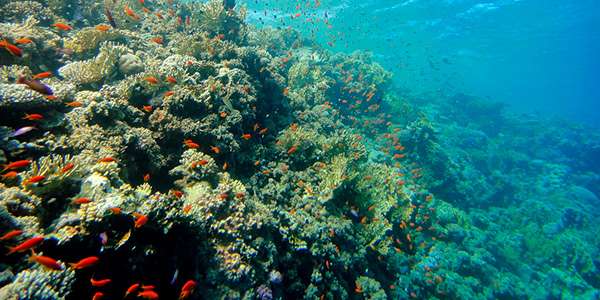 This is the most colourful reef in the Straits of Tiran.Dives are usually made on the eastern side of the reef where the water is calmer. When conditions are good and if air consumption permits, it is possible to circumnavigate the reef. The reef reaches from 0.5 to 28m where it forms a plateau. There is a row of Gorgonian Fans that house Long Nose Hawk Fish, different species of Nudibranchs and Pipe Fish. Near this spectacular site is a small soft coral garden. Here divers have a good chance of seeing Turtles having lunch. On the wall itself you find small pinnacles encrusted with coral and with lots of Anthias. Looking away from the reef divers may see Unicorn Fish, Redtooth Trigger Fish, and schools of Jacks and Trevallies.
This is the most colourful reef in the Straits of Tiran.Dives are usually made on the eastern side of the reef where the water is calmer. When conditions are good and if air consumption permits, it is possible to circumnavigate the reef. The reef reaches from 0.5 to 28m where it forms a plateau. There is a row of Gorgonian Fans that house Long Nose Hawk Fish, different species of Nudibranchs and Pipe Fish. Near this spectacular site is a small soft coral garden. Here divers have a good chance of seeing Turtles having lunch. On the wall itself you find small pinnacles encrusted with coral and with lots of Anthias. Looking away from the reef divers may see Unicorn Fish, Redtooth Trigger Fish, and schools of Jacks and Trevallies.
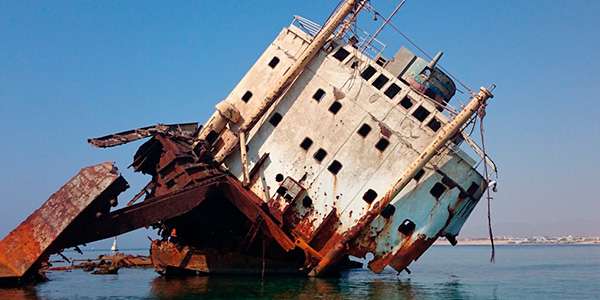 Famous for the stranded wreck Louilla this is the largest reef in diameter of all the reefs in the Straits. There is a shallow sandy area close to the reef with Blue Spotted Sting Rays, Cornet Fish, schooling Goat Fish and baby Napoleons. Next to this spot is a plateau of hard coral with schools of reef fish, such as Banner Fish, Butterfly Fish and Parrot Fish. The plateau ends in a drop off where divers may spot magnificent creatures, such as Manta Rays, Eagle Rays, Potato Groupers and often White Tip Sharks passing by.
Famous for the stranded wreck Louilla this is the largest reef in diameter of all the reefs in the Straits. There is a shallow sandy area close to the reef with Blue Spotted Sting Rays, Cornet Fish, schooling Goat Fish and baby Napoleons. Next to this spot is a plateau of hard coral with schools of reef fish, such as Banner Fish, Butterfly Fish and Parrot Fish. The plateau ends in a drop off where divers may spot magnificent creatures, such as Manta Rays, Eagle Rays, Potato Groupers and often White Tip Sharks passing by.
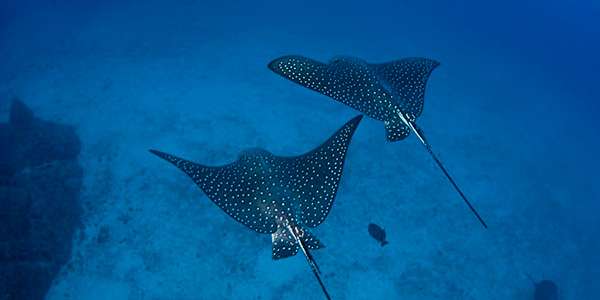 Ras Ghamila is a long plateau covered with table corals and soft corals. This is one of the most beautiful dives in Sharm El Sheikh. This dive is usually done as an optional third dive after two morning dives in the Straits of Tiran. Under the table corals divers may see Crocodile Fish, Blue Spotted Sting Rays and Groupers hiding. Strong currents are often present, making drift dives in this area very exciting! At the corner of the dive site schools of black Snappers are quite common. Expect to see Cornet Fish stalking their prey by hiding behind larger fish.
Ras Ghamila is a long plateau covered with table corals and soft corals. This is one of the most beautiful dives in Sharm El Sheikh. This dive is usually done as an optional third dive after two morning dives in the Straits of Tiran. Under the table corals divers may see Crocodile Fish, Blue Spotted Sting Rays and Groupers hiding. Strong currents are often present, making drift dives in this area very exciting! At the corner of the dive site schools of black Snappers are quite common. Expect to see Cornet Fish stalking their prey by hiding behind larger fish.
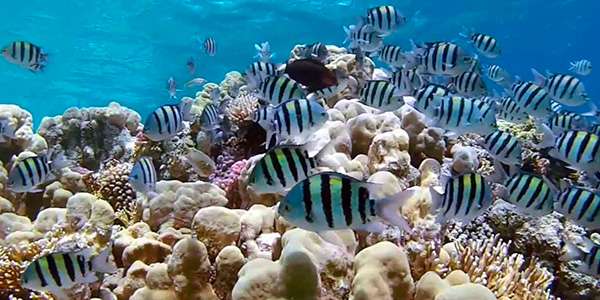 Swim throughs and narrow caves are the highlights of this dive site.
A wall descends from the surface to about 16m, encrusted with corals. The swim throughs and caves are hidden in this wall. There is a Table Coral which houses a school of Glass Fish. Sloping down from the wall is a sandy area with a vast eel garden.
Swim throughs and narrow caves are the highlights of this dive site.
A wall descends from the surface to about 16m, encrusted with corals. The swim throughs and caves are hidden in this wall. There is a Table Coral which houses a school of Glass Fish. Sloping down from the wall is a sandy area with a vast eel garden.
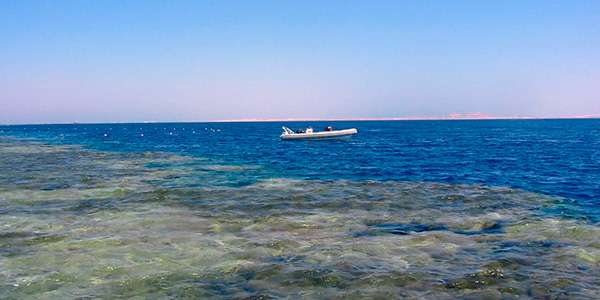 This site can be accessed by four wheel drive vehicle as well as boats. The reef drops from the shallow bays to a wall down to 60m+ with many caves and overhangs. The best diving is among the big coral heads (or ergs) in the shallow areas. A good spot for Spanish dancers and coneshells in the sandy gullies.
This site can be accessed by four wheel drive vehicle as well as boats. The reef drops from the shallow bays to a wall down to 60m+ with many caves and overhangs. The best diving is among the big coral heads (or ergs) in the shallow areas. A good spot for Spanish dancers and coneshells in the sandy gullies.
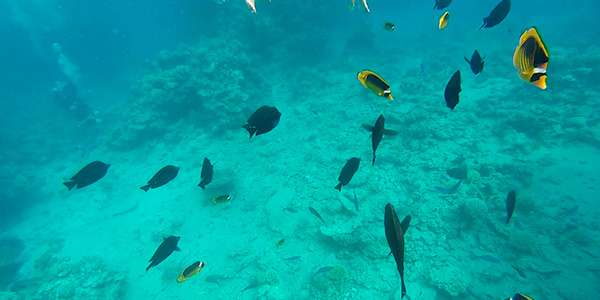 A canyon is the highlight of this dive site. It extends from 5 to 50m.The canyon offers a beautiful underwater landscape, its walls covered in hard coral, and with small passages leading to the main reef. On the reef you find small pinnacles that are home to anemones with Clown Fish, as well as Nudibranchs and Pipe Fish. There is an eel garden at 10m.
A canyon is the highlight of this dive site. It extends from 5 to 50m.The canyon offers a beautiful underwater landscape, its walls covered in hard coral, and with small passages leading to the main reef. On the reef you find small pinnacles that are home to anemones with Clown Fish, as well as Nudibranchs and Pipe Fish. There is an eel garden at 10m.
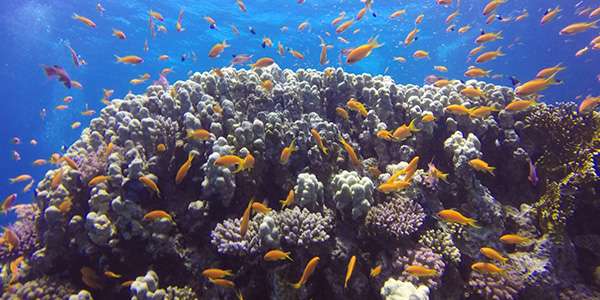 The Gardens Bay accommodates four dive sites.
Far Garden and Near Garden are at the extremes of the bay and are both steep walls that end in coral gardens.
Fiddle Garden has a wall to 6m, followed by a sandy slope, then a drop off starting at 18m.
Middle Garden has a sandy area ending in a garden of hard coral that slopes down to about 70m.
There is a great variety of marine life in this area and it is a channel for big creatures such as Manta Rays and Whale Sharks.
The Gardens Bay accommodates four dive sites.
Far Garden and Near Garden are at the extremes of the bay and are both steep walls that end in coral gardens.
Fiddle Garden has a wall to 6m, followed by a sandy slope, then a drop off starting at 18m.
Middle Garden has a sandy area ending in a garden of hard coral that slopes down to about 70m.
There is a great variety of marine life in this area and it is a channel for big creatures such as Manta Rays and Whale Sharks.
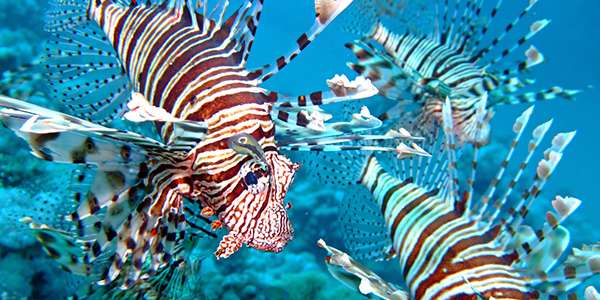 This site is immediately northeast of the much better known and more popular Tower. This is a very easy drift dive that allows you to observe many species of coral, both hard and soft and a wide range of reef fauna. From March to the end of June it is a great hangout for passing Manta and the occasional White Tip Reef Shark.
This site is immediately northeast of the much better known and more popular Tower. This is a very easy drift dive that allows you to observe many species of coral, both hard and soft and a wide range of reef fauna. From March to the end of June it is a great hangout for passing Manta and the occasional White Tip Reef Shark.
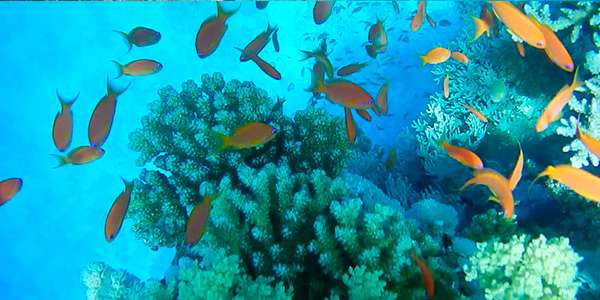 At Tower a wide canyon extends from the surface to beyond 100 m. A must do dive in Sharm El Sheikh. Inside the canyon at about 14m is a shelter for Potato Groupers and sometimes divers may see White Tip Reef Sharks sleeping there. Following the canyon you get to a slope with tall pinnacles, some almost reaching the surface. The pinnacles are encrusted with coral and are home to Lion Fish, Nudibranchs and Peppered Morays. Whale Sharks and Manta Rays are spotted on this site.
At Tower a wide canyon extends from the surface to beyond 100 m. A must do dive in Sharm El Sheikh. Inside the canyon at about 14m is a shelter for Potato Groupers and sometimes divers may see White Tip Reef Sharks sleeping there. Following the canyon you get to a slope with tall pinnacles, some almost reaching the surface. The pinnacles are encrusted with coral and are home to Lion Fish, Nudibranchs and Peppered Morays. Whale Sharks and Manta Rays are spotted on this site.
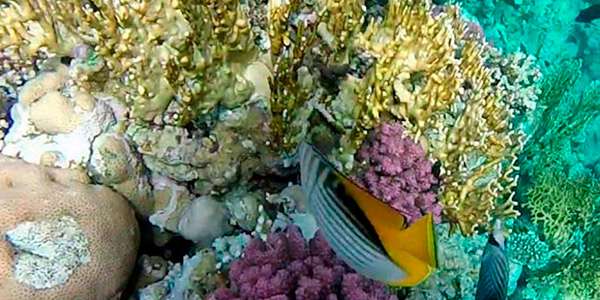 The name of this site derives from 17th century shipwreck of a Turkish vessel with a cargo of amphoras containing mercury. Amphoras lies southwest of Tower and is generally dived in the afternoon as a drift. The topography is quite simple, a sandy slope that begins at 12m that has many coral pinnacles to explore for small pipefish, nudibranch and scorpionfish hiding amongst the nooks and crannies. Although there are not many, the remains of the Turkish vessel cargo are always fascinating. The most interesting part lies between 18m and 25m.
The name of this site derives from 17th century shipwreck of a Turkish vessel with a cargo of amphoras containing mercury. Amphoras lies southwest of Tower and is generally dived in the afternoon as a drift. The topography is quite simple, a sandy slope that begins at 12m that has many coral pinnacles to explore for small pipefish, nudibranch and scorpionfish hiding amongst the nooks and crannies. Although there are not many, the remains of the Turkish vessel cargo are always fascinating. The most interesting part lies between 18m and 25m.
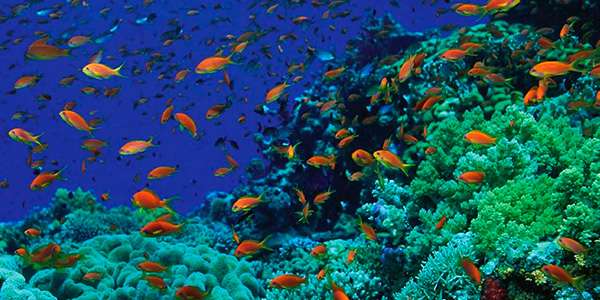 Northern side of Ras Umm Sidd wall, fully decorated ergs rise from a gentle slope, home to schools of glass fish against a colourful background of soft corals.
Northern side of Ras Umm Sidd wall, fully decorated ergs rise from a gentle slope, home to schools of glass fish against a colourful background of soft corals.
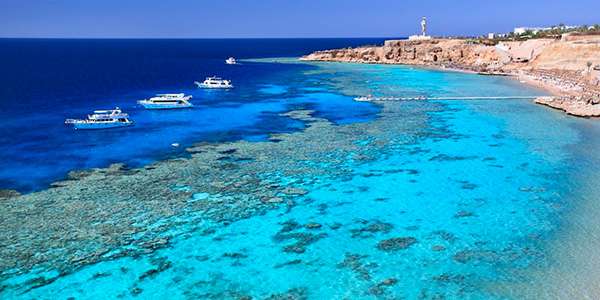 Abundant marine life, including schools of Barracudas are characteristics of this dive site.
The site has a wall reaching from the surface to 18m, forming a plateau that extends for about 50m to the drop off. On the plateau divers find pinnacles with Scorpion Fish camouflaged in the coral and Bat Fish hovering. Blue Spotted Sting Rays are found resting on the sandy area. The highlight of this dive is a column of Gorgonian Fans that reaches from 14 to 28m. At the far corner of the dive site, where currents meet, divers may spot schools of Snappers, Barracudas and large Napoleons. On the other side you find one of the most amazing coral gardens in Sharm El Sheikh. It has small pinnacle formations with soft coral and abundant marine life. You find small creatures such as Nudibranchs, and Devil Scorpion Fish here.
Abundant marine life, including schools of Barracudas are characteristics of this dive site.
The site has a wall reaching from the surface to 18m, forming a plateau that extends for about 50m to the drop off. On the plateau divers find pinnacles with Scorpion Fish camouflaged in the coral and Bat Fish hovering. Blue Spotted Sting Rays are found resting on the sandy area. The highlight of this dive is a column of Gorgonian Fans that reaches from 14 to 28m. At the far corner of the dive site, where currents meet, divers may spot schools of Snappers, Barracudas and large Napoleons. On the other side you find one of the most amazing coral gardens in Sharm El Sheikh. It has small pinnacle formations with soft coral and abundant marine life. You find small creatures such as Nudibranchs, and Devil Scorpion Fish here.
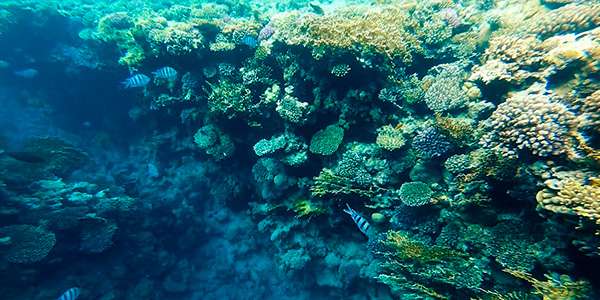 This dive site takes the name Temple from its majestic formation of coral columns. Temple has a large pinnacle, far from the main reef, that reaches up to the surface. Divers may find Giant Morays, Blue Spotted Sting Rays, large groups of Lion Fish, and Scorpion Fish on the pinnacle. The site also boasts colourful corals in many shapes and Gorgonian Fans.
This dive site takes the name Temple from its majestic formation of coral columns. Temple has a large pinnacle, far from the main reef, that reaches up to the surface. Divers may find Giant Morays, Blue Spotted Sting Rays, large groups of Lion Fish, and Scorpion Fish on the pinnacle. The site also boasts colourful corals in many shapes and Gorgonian Fans.
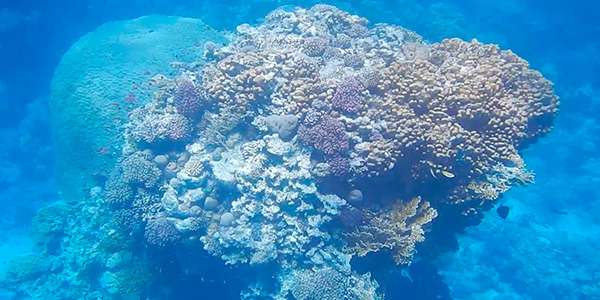 Ideal spot for learning to dive in the Red Sea. Offers calm conditions due to its location in a bay. Ras Katy has a main pinnacle, 30m from the main reef, which goes from the surface to 18m. And a drop off nearby descends to 70m. Divers can find schools of Fusiliers, Clown Fish, Pipe Fish and large Napoleons around this pinnacle. The hard coral here is in good condition, especially the Fire Coral.
Ideal spot for learning to dive in the Red Sea. Offers calm conditions due to its location in a bay. Ras Katy has a main pinnacle, 30m from the main reef, which goes from the surface to 18m. And a drop off nearby descends to 70m. Divers can find schools of Fusiliers, Clown Fish, Pipe Fish and large Napoleons around this pinnacle. The hard coral here is in good condition, especially the Fire Coral.
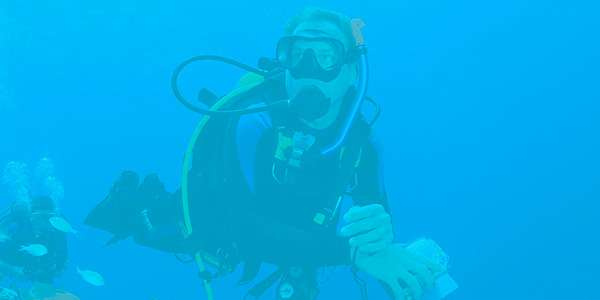 One of the most beautiful dive sites in the Ras Mohammed National Park. Turtles are easy to spot in this area and the corals are pristine. The ancient table corals serve as a resting place for Marble Groupers and divers may see Crocodile Fish and Blue Spotted Sting Rays underneath them. There are many Gorgonian Fans along the edge of the drop off. Eagle Rays and Whale Sharks come to feed on plankton brought up from the depth by currents.
One of the most beautiful dive sites in the Ras Mohammed National Park. Turtles are easy to spot in this area and the corals are pristine. The ancient table corals serve as a resting place for Marble Groupers and divers may see Crocodile Fish and Blue Spotted Sting Rays underneath them. There are many Gorgonian Fans along the edge of the drop off. Eagle Rays and Whale Sharks come to feed on plankton brought up from the depth by currents.
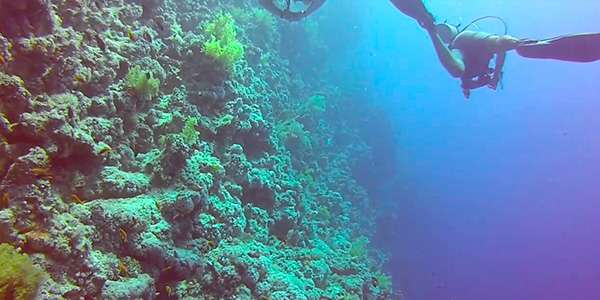 The wall in Ras Zatar descends to about 45m. This dive is a must in the Ras Mohammed National Park. There are overhangs on the wall where divers may find Potato Groupers resting, and pinnacles covered with purple, pink and green soft coral serving as homes for Nudibranchs and Pipe Fish. At 22m you see a pinnacle with a Table Coral, surrounded by Glass Fish. If divers get really close to the cavities of this pinnacle they can see Boxer Shrimps and Cleaner Shrimps having a feast. Light penetrates parts of the wall, giving the impression of a cathedral. Juvenile fish can be spotted on the plateau at the corner of the reef.
The wall in Ras Zatar descends to about 45m. This dive is a must in the Ras Mohammed National Park. There are overhangs on the wall where divers may find Potato Groupers resting, and pinnacles covered with purple, pink and green soft coral serving as homes for Nudibranchs and Pipe Fish. At 22m you see a pinnacle with a Table Coral, surrounded by Glass Fish. If divers get really close to the cavities of this pinnacle they can see Boxer Shrimps and Cleaner Shrimps having a feast. Light penetrates parts of the wall, giving the impression of a cathedral. Juvenile fish can be spotted on the plateau at the corner of the reef.
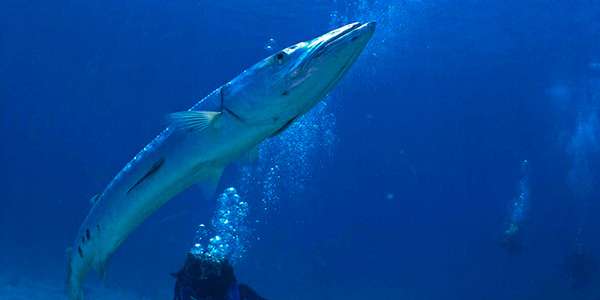 Here is one of the most exciting dive sites in Ras Mohammed.It offers divers three highlights, a wall, a coral garden and a satellite reef. The sheer wall is very porous with lots of small crevices. It has a couple of penetrable caves, each with separate entrances and exits. The wall becomes a sandy plateau where divers may find Blue Spotted Sting Rays, Feather Tail Rays and Eagle Rays. The coral garden ranges from 10 to 18m ending in the satellite reef. This reef, 50m away from the main reef, consists of small pinnacles covered with soft corals and Gorgonian Fans. For the more adventurous, the drop off on the edge of the satellite reef usually presents stronger currents bringing big creatures to feed.
Here is one of the most exciting dive sites in Ras Mohammed.It offers divers three highlights, a wall, a coral garden and a satellite reef. The sheer wall is very porous with lots of small crevices. It has a couple of penetrable caves, each with separate entrances and exits. The wall becomes a sandy plateau where divers may find Blue Spotted Sting Rays, Feather Tail Rays and Eagle Rays. The coral garden ranges from 10 to 18m ending in the satellite reef. This reef, 50m away from the main reef, consists of small pinnacles covered with soft corals and Gorgonian Fans. For the more adventurous, the drop off on the edge of the satellite reef usually presents stronger currents bringing big creatures to feed.
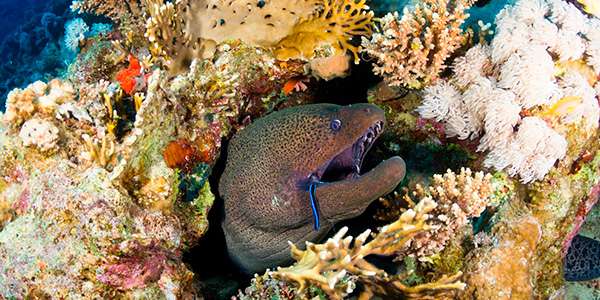 Eel Garden is situated in front of a small beach south immediately before Sharks Observatory. Eel Garden is well sheltered from the currents but since it is exposed to prevailing winds and waves divers must pay close attention to the condition of the sea. The dive is extremely easy and the route winds through the sandy plateau slightly inclined to the east opposite the beach. On the central part of the sandy ledge there is a small cave out of which appears to flow an impressive V-shaped stream of sand. The middle section of the plateau is populated by a lovely colony of Garden eels.
Eel Garden is situated in front of a small beach south immediately before Sharks Observatory. Eel Garden is well sheltered from the currents but since it is exposed to prevailing winds and waves divers must pay close attention to the condition of the sea. The dive is extremely easy and the route winds through the sandy plateau slightly inclined to the east opposite the beach. On the central part of the sandy ledge there is a small cave out of which appears to flow an impressive V-shaped stream of sand. The middle section of the plateau is populated by a lovely colony of Garden eels.
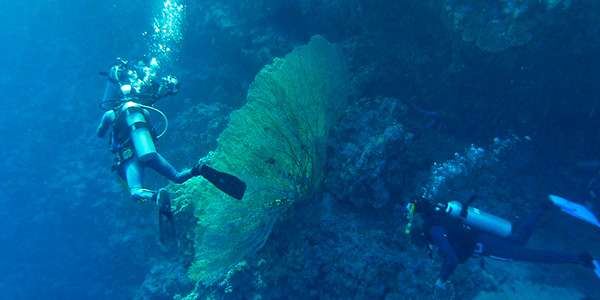 This site takes its name from the cliff top from which it used to be possible to spot sharks in the waters below. Nowadays it is famous for its overhangs and rows of Gorgonian Fans that make the underwater landscape different from other sites in Ras Mohammed. The wall dive is famous among Tec divers due to its drop off that reaches beyond 100m. Hawksbill Turtles are common in the area, munching on purple and pink corals that grow along the wall. Different species of Nudibranchs are easily found on the many overhangs. The Gorgonian Fans make a very nice effect on the reef. Looking away from the the wall schools of Fusiliers, Jacks and Unicorn Fish are commonly seen passing by.
This site takes its name from the cliff top from which it used to be possible to spot sharks in the waters below. Nowadays it is famous for its overhangs and rows of Gorgonian Fans that make the underwater landscape different from other sites in Ras Mohammed. The wall dive is famous among Tec divers due to its drop off that reaches beyond 100m. Hawksbill Turtles are common in the area, munching on purple and pink corals that grow along the wall. Different species of Nudibranchs are easily found on the many overhangs. The Gorgonian Fans make a very nice effect on the reef. Looking away from the the wall schools of Fusiliers, Jacks and Unicorn Fish are commonly seen passing by.
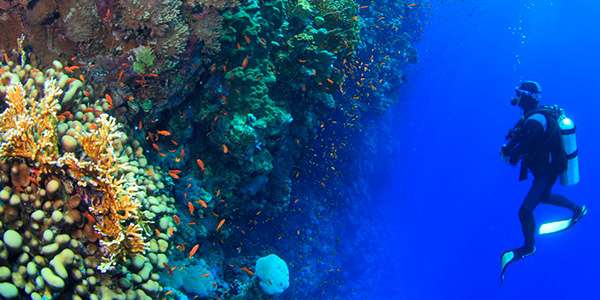 Shark Reef is one of the top 10 dive sites in the world. The wall here reaches down to 800m. The currents from the Gulf of Aqaba blend with currents from the Gulf of Suez, bringing lots of nutrients. This phenomenon creates the perfect conditions for a rich variety of corals to thrive. You see Acroporas, Brain Coral, Fire Coral, Brocoli Coral and Pulsing Polyp Coral among many others here. Huge schools of Snappers, Bat Fish, Barracudas, Unicorn Fish and Jack Fish hover by the steep wall of the reef.
Shark Reef is one of the top 10 dive sites in the world. The wall here reaches down to 800m. The currents from the Gulf of Aqaba blend with currents from the Gulf of Suez, bringing lots of nutrients. This phenomenon creates the perfect conditions for a rich variety of corals to thrive. You see Acroporas, Brain Coral, Fire Coral, Brocoli Coral and Pulsing Polyp Coral among many others here. Huge schools of Snappers, Bat Fish, Barracudas, Unicorn Fish and Jack Fish hover by the steep wall of the reef.
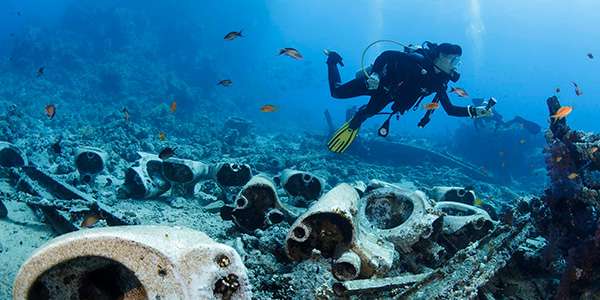 This is the richest coral garden in Ras Mohammed. Yolanda reef has a small wall coming from the surface that forms a plateau from 12 to 20m. Many small pinnacles with colourful soft corals and abundant marine life can be found on the plateau. The ship Yolanda crashed on the reef in the 1980's and lay on its side until a storm pushed it over the edge and down to 180m. Some remains of the ship and its cargo still lie in shallow water. Yolanda carried toilets, bath tubs and sinks, all now encrusted with corals and home to Blue Spotted Stingrays, Scorpion and Stone Fish, Giant Morays and the resident Napoleon Wrasse.
This is the richest coral garden in Ras Mohammed. Yolanda reef has a small wall coming from the surface that forms a plateau from 12 to 20m. Many small pinnacles with colourful soft corals and abundant marine life can be found on the plateau. The ship Yolanda crashed on the reef in the 1980's and lay on its side until a storm pushed it over the edge and down to 180m. Some remains of the ship and its cargo still lie in shallow water. Yolanda carried toilets, bath tubs and sinks, all now encrusted with corals and home to Blue Spotted Stingrays, Scorpion and Stone Fish, Giant Morays and the resident Napoleon Wrasse.
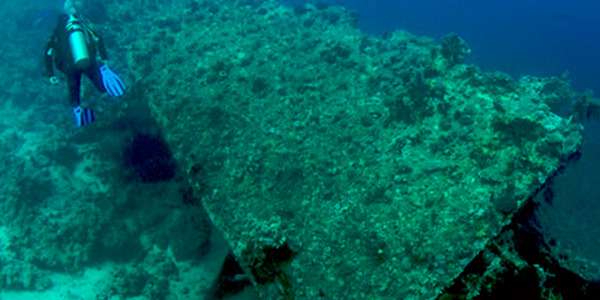 Dunraven is a popular wreck in the Red Sea. She was carrying spices, cotton and timber from India when she hit the reef in 1876, caught fire and sank. The wreck lies upside down at 30m and resembles a large cave. Inside divers can find schools of Yellow Goat Fish, and Giant Morays. The hull is encrusted with corals and full of marine life, such as Nudibranchs, Pipe Fish and the very rare Ghost Pipe Fish.
Dunraven is a popular wreck in the Red Sea. She was carrying spices, cotton and timber from India when she hit the reef in 1876, caught fire and sank. The wreck lies upside down at 30m and resembles a large cave. Inside divers can find schools of Yellow Goat Fish, and Giant Morays. The hull is encrusted with corals and full of marine life, such as Nudibranchs, Pipe Fish and the very rare Ghost Pipe Fish.
 The world famous wreck SS Thistlegorm was sunk in 1941 in the Gulf of Suez. She was loaded with a cargo of armoured Bren-Gun carriers, BSA motorcycles, jeeps, trucks, rolling stock, aeroplane parts, stacks of rifles, radio equipment, munitions, and a plentiful supply of Wellington boots. The Thistlegorm is a heaven for wreck enthusiasts, but is also one of the most underrated fish dives in the area, attracting schooling Barracuda and providing a hunting ground for giant Tuna and Snapper.
The world famous wreck SS Thistlegorm was sunk in 1941 in the Gulf of Suez. She was loaded with a cargo of armoured Bren-Gun carriers, BSA motorcycles, jeeps, trucks, rolling stock, aeroplane parts, stacks of rifles, radio equipment, munitions, and a plentiful supply of Wellington boots. The Thistlegorm is a heaven for wreck enthusiasts, but is also one of the most underrated fish dives in the area, attracting schooling Barracuda and providing a hunting ground for giant Tuna and Snapper.